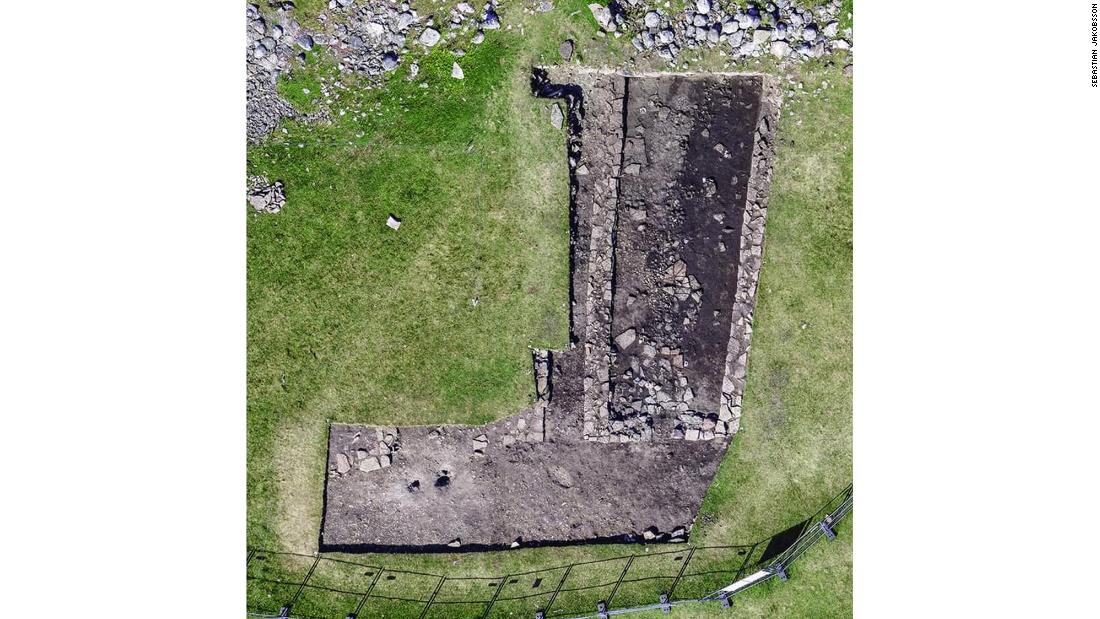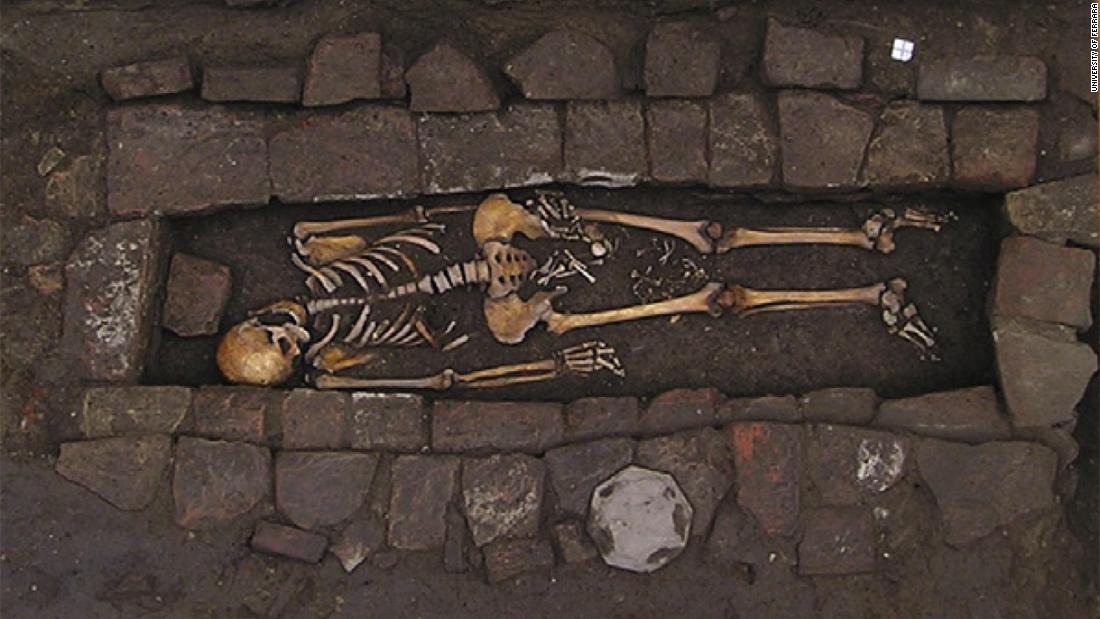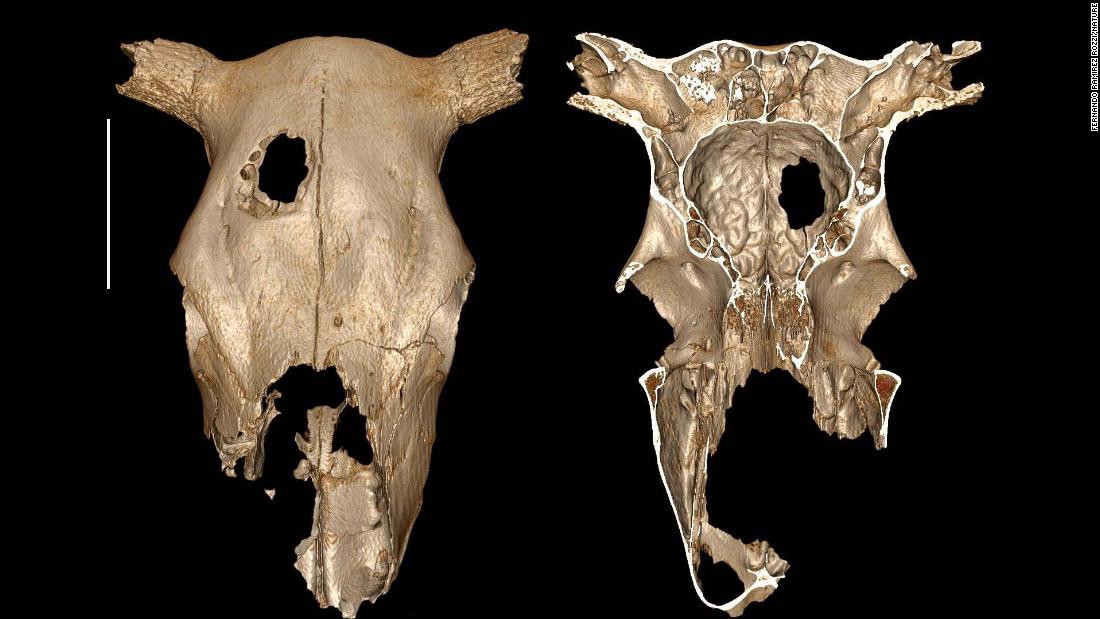
(CNN)About 1,500 years ago, something terrible happened at Sandby borg, a ringfort on the beautiful island of land, off Sweden's southeast Baltic coast.
Yearly excavations beginning in 2011 provided the first clues to the island's grisly secret. The digging uncovered the skeletons of dozens of people who had never been buried; they had been left where they fell. The remains carried signs of killing blows from blunt objects.
The researchers had stumbled on the site of a terrible massacre that claimed the lives of babies, adolescents and adult men.
None of the skeletons has been identified as female, suggesting that any women were taken from the area or evacuated ahead of time. The presence of babies, children and jewelry offers proof that women did occupy Sandby borg at some point before their menfolk were slaughtered.
Researchers know that this was a culture that cremated their dead, but no one ever returned to care for the victims of the massacre. In fact, evidence suggests that the ringfort was abandoned immediately and left undisturbed. It's not unlike a gory scene from "Game of Thrones."
The evidence of the killings and their aftermath remains frozen in time. Whoever murdered the ringfort's inhabitants didn't take their valuables, livestock or food. The researchers found that much was left behind, including the remains of a very delicate half-eaten herring by a fireplace.
A new study of the remains and artifacts recovered at the site was published last week in the journal Antiquity.
"I think what makes Sandby borg so special is the character of the archaeological source material, with unburied bodies of slain people of all ages and a 'frozen moment' character that you very rarely find in land archaeology," study co-author Ludvig Papmehl-Dufay wrote in an email. Papmehl-Dufay is an archaeologist at the Kalmar County Museum in Sweden.
"I say 'land archaeology' since it almost resembles the situation that you would expect to find on a marine wreck site, where an unforeseen event created a time capsule of a specific moment. It's a truly horrifying image that emerges from our excavations, but at the same time it gives us a rare opportunity to study aspects of violence and everyday life that we don't normally see."
'Something terrible had happened'
Although the location is idyllic, the time period during which the massacre victims lived was a turbulent one, the researchers said. The European Migration period, which lasted from about A.D. 400 to 550, saw the decline of the Western Roman Empire, a Hun invasion and a shifting alliance with the Germanic populations in the northern parts of Europe, according to the study.
War and famine led to a social and economic crisis that saw farms and settlements abandoned and destroyed. Sandy borg and its people would inevitably have been affected by what was happening around them.
Öland Island has been an archaeological treasure trove for researchers over the years, with more than 1,000 stone house foundations, cemeteries, graves, 15 ringforts and artifacts like gold Roman coins, bronze statuettes and glass beakers. The coins can be dated from the early fifth century.
Although the findings at Sandby borg add greatly to the rare archaeological finds from Öland, they are of a different nature.
"Already in the first year of excavation, back in 2011, it was realised that something terrible had happened that involved dead, unburied people inside houses in the fort," Papmehl-Dufay said. "The following year, 2012, it became clear that some of the dead were murdered, with clear evidence ofsharp-force trauma.Of course this did affect us, for some probably more than others. At least for me, it is really an emotional thing to excavate this place, especially perhaps when we find remains of kids and small babies."
The researchers found remains of 26 people, animal skeletons including those of dogs and horses, and numerous artifacts.
Nine skeletons were found in one home, all male or displaying masculine traits. One was only 1½ to 3 months old, and another was between 2 and 5 years old. Several skulls, including that of an adolescent, showed signs of blunt-force trauma.
The position of some of the skeletons suggests that they experienced sudden death or fell into an unconscious state. An adolescent was found on his side, indicating a slower death. Another adolescent was found on its back, feet on top of the pelvis of an adult. He most likely fell backward over an adult on the floor.
In another home, the skeleton of an elderly man was found where he fell across a burning hearth, and other skulls of the skeletons in that home sustained different types of trauma aimed at the back or side of their bodies.
Signs of charring led the researchers to believe that the attackers attempted to set fire to the homes or an accidental fire broke out during the massacre. The skeletons of humans and animals were found inside the homes or the entrances of their homes, as well as in the streets. The animals may have been slaughtered during the attack or died of starvation after the massacre when there was no one to tend them.
Newly slaughtered lambs, most likely killed for food in the ringfort before the massacre, were found in a type of storage area. This helped the researchers determine that the massacre was carried out between late spring and early autumn.
The artifacts discovered at the site include stashes of period jewelery that were hidden in deposits, like gilded brooches, glass beads, rings and silver pendants. The large, locally made brooches were intricate and valuable, with silver designs, probably the ornamentation for aristocratic women. But the millefiori glass beads, silver bell pendants and shell ornaments were brought in, most likely from Poland, the Baltic states and parts of the Roman Empire, the study said.
Researchers excavated two of the 53 houses completely and 50% of a third home and conducted a small investigation into six of the homes. This revealed ceramics, bronze, silver, gold and iron objects, more glass and silver beads, a silver sword pendant and a Roman coin.
But weapons were limited at the site, with only some arrowheads, a lance-head and some sword fittings recovered. Either the Sandby borg residents weren't expecting a fight, or the weapons were taken after the massacre, the researchers said.
"There is this strange and really strong contrast between the beauty of the site today on one hand, placed right by the sea in a wonderful idyllic landscape, and the terrifying evidence of this brutal and chaotic massacre on the other," Papmehl-Dufay said.
Will we ever know what happened?
Although the site reveals an unusually detailed look at domestic life during a time when cremation was the custom and what a sudden, brutal attack would have looked like, many questions remain for the researchers.
Was the attack a gender-biased one? Why did no one ever return? Why didn't the residents have any weapons? It's possible that the women were taken or evacuated, that the residents who survived were never allowed to return and that -- as discovered at other sites from this time period -- the weapons were taken or discarded in lakes or marshes.
But who did this? That mystery lingers, because there are no identifying signs from the killers. The researchers believe that after the fall of the Western Roman Empire and the political instability that followed, power struggles could have grisly results like this massacre.
"There are no contemporary historical sources that to our knowledge refer to events that could be linked to the massacre at Sandby borg," Papmehl-Dufay said. "Speculations of 'suspects' are mainly based on conclusions and indications from the archaeological evidence on the island of Öland, suggesting an internal power struggle between different elite groups.
"There's a whole load of questions surrounding this site, some concerning the attack and the victims (and the perpetrators) and others concerning the ringfort, its biographical history (before and after the massacre) and it's surroundings," he said. "The project continues and as always, the more we dig the more questions will arise."
Original Article : HERE ; This post was curated & posted using : RealSpecific
=>
***********************************************
Originally Published Here: Skeletons tell story of ‘truly horrifying’ fifth-century massacre
************************************
=>
Sponsored by SmartQuotes - Your daily smart quote
=>
This article was searched, compiled, delivered and presented using RSS Masher & TrendingTraffic
=>>
Skeletons tell story of ‘truly horrifying’ fifth-century massacre was originally posted by Viral News 2







No comments:
Post a Comment